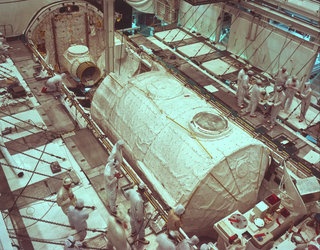Space Shuttle fleet
The Space Shuttle was the first reusable spacecraft, making it possible to build a fleet of vehicles that were launched and then refurbished after landing for their next missions.
Starting with Columbia and continuing with Challenger, Discovery, Atlantis and Endeavour, the spacecraft has carried people into orbit repeatedly, launched, recovered and repaired satellites, conducted research and built the largest structure in space, the International Space Station.
The five Orbiters have accumulated (before the last flight of Atlantis) on 134 missions 1316 days 19 hours 24 minutes 43 seconds in flight and made 20 958 orbits of Earth.
The Shuttles docked with Russia’s Mir space station nine times and flew to International Space Station 36 times – Atlantis is making the 37th visit.
Enterprise

The first Space Shuttle (Orbital Vehicle 101, OV-101) was not built for space missions: it was used for unpowered test flights at NASA's Dryden Test Flight Center at the Edwards Air Force Base in California.
The Shuttle was lifted atop a modified Boeing 747 Shuttle Carrier Aircraft and made five test flights totalling 19 minutes of free flight.
The first flight was made on 12 August 1977 and the last on 26 October of the same year.
Enterprise is on display at the Smithsonian Institution's Steven F. Udvar-Hazy Center near Washington DC, USA. When Discovery replaces it at the museum, Enterprise will be moved to the Intrepid Sea-Air-Space Museum in New York.
Columbia

Columbia (OV-102) was the first Shuttle to fly to space and as the oldest member of the fleet it was slightly heavier than its successors, which benefited from advances in technology.
The first four flights of Columbia put the spacecraft through its paces. It was equipped with ejection seats, activated for the test flights and removed after the ninth flight.
Columbia was destroyed during reentry on 1 February 2003 when it was coming back to home from STS-107, its 28th flight. The seven astronauts died in the accident, one of the reasons which brought about the end of the Space Shuttle programme.
Columbia spent 300 days 17 hours 46 minutes 42 seconds in space, completed 4808 orbits, and flew 201 497 772 km.
Challenger

Challenger started its career as Structural Test Article STA-099. After studying the work needed to make Enterprise space-worthy , NASA calculated that it was less expensive to rebuild STA-099 as OV-099.
Challenger made its first flight on the STS-6 mission in April 1983 and became the workhorse of NASA's fleet during the early years of Shuttle operations: Challenger flew on 85% of all missions up to 1985.
Challenger was destroyed during the launch of its tenth mission, on 28 January 1986, killing all seven members of the crew.
It completed nine flights before the last ill-fated launch, totalling 62 days 07 hours 56 minutes 15 seconds. Challenger orbited Earth 995 times.
Discovery

Discovery (OV-103) was the hardest-working Shuttle, with 39 successful missions during 27 years of service since its debut in August 1984.
It was the third operational vehicle following Columbia and Challenger, and had the honour of delivering the Hubble Space Telescope into orbit. It was the Shuttle tasked with the two ‘return to flight’ missions after the Challenger and Columbia accidents.
Discovery was officially decommissioned after the STS-133 mission last February. After months of preparation, it will be handed over to the Smithsonian Institution’s National Air and Space Museum. Discovery will replace Enterprise at the Steven F. Udvar-Hazy Center in Virginia, near Washington Dulles Airport.
Discovery made 5830 orbits and spent in total more than a year on missions: 365 days 12 hours 53 minutes 34 seconds.
Atlantis

Atlantis (OV-104) was the fourth vehicle. Since October 1985 it has flown 32 missions and will make the last, STS-135.
In 1989, it deployed Magellan to Venus and Galileo to Jupiter; it lofted the Compton Gamma Ray Observatory to orbit in 1991. Atlantis was the first Shuttle to dock with a space station, when it linked up with Russia’s Mir in 1995. It also delivered Europe’s Columbus laboratory to the International Space Station in 2008.
According to statistics, Atlantis was built in about half the time it took to complete the first operational craft, Columbia. Atlantis has had the fewest technical problems.
After its last flight, it will be handed over to the Kennedy Space Center Visitor Complex for display.
Before STS-135, Atlantis has accumulated 293 days 18 hours 29 minutes 37 seconds in flight, and circled Earth 4648 times.
Endeavour

Endeavour (OV-105) is the youngest fleet member, making its maiden voyage in May 1992. It was built as a replacement for Challenger (lost in 1986) using the spare structural parts of Discovery and Atlantis.
It was the first Shuttle at the International Space Station, in 1998, delivering Node-1, the Station’s first US element.
Endeavour flew its final mission last May, STS-134, and it has been decommissioned. Its Canadarm will be sent to Canada, and the Shuttle itself will be given to the California Science Center in Los Angeles – not far from Palmdale, where it was built, and Edwards Air Force Base, the second landing strip for returning Shuttles.
Endeavour completed 25 missions with 4677 orbits and spent in total 296 days 2 hours 18 minutes 35 seconds in flight.















 Germany
Germany
 Austria
Austria
 Belgium
Belgium
 Denmark
Denmark
 Spain
Spain
 Estonia
Estonia
 Finland
Finland
 France
France
 Greece
Greece
 Hungary
Hungary
 Ireland
Ireland
 Italy
Italy
 Luxembourg
Luxembourg
 Norway
Norway
 The Netherlands
The Netherlands
 Poland
Poland
 Portugal
Portugal
 Czechia
Czechia
 Romania
Romania
 United Kingdom
United Kingdom
 Slovenia
Slovenia
 Sweden
Sweden
 Switzerland
Switzerland






























